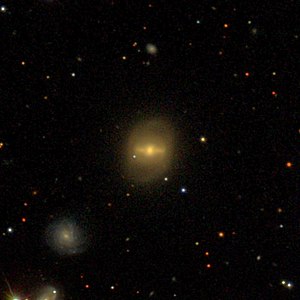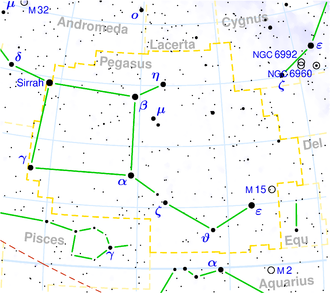NGC 7147
| Galaxy NGC 7147 |
|
|---|---|

|
|
| SDSS recording | |
| AladinLite | |
| Constellation | Pegasus |
|
Position equinox : J2000.0 , epoch : J2000.0 |
|
| Right ascension | 21 h 51 m 58.4 s |
| declination | + 03 ° 04 ′ 18 ″ |
| Appearance | |
| Morphological type | SB (s) 0+: |
| Brightness (visual) | 13.6 mag |
| Brightness (B-band) | 14.5 mag |
| Angular expansion | 1.0 '× 0.9' |
| Position angle | 5 ° |
| Surface brightness | 13.3 mag / arcmin² |
| Physical data | |
| Affiliation | WBL 672 |
| Redshift | 0.030741 ± 0.000100 |
| Radial velocity | 9216 ± 30 km / s |
|
Stroke distance v rad / H 0 |
(419 ± 29) · 10 6 ly (128.4 ± 9.0) Mpc |
| history | |
| discovery | Albert Marth |
| Discovery date | August 11, 1863 |
| Catalog names | |
| NGC 7147 • PGC 67518 • CGCG 376-045 • MCG + 00-55-025 • 2MASX J21515839 + 0304184 • | |
NGC 7147 is a lenticular galaxy of the Hubble type SB0 / a in the constellation Pegasus in the northern sky . It is an estimated 419 million light years from the Milky Way and about 120,000 light years in diameter.
In the same area of the sky is u. a. the galaxy NGC 7146 , NGC 7149 , NGC 7156 , IC 1407 .
The object was discovered by Albert Marth on August 11, 1863 .
